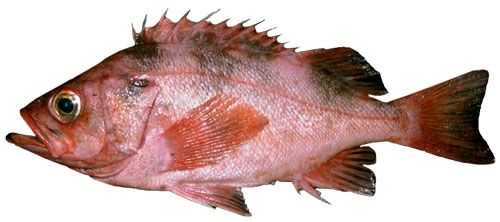Sharpchin Rockfish

Species Details
Sebastes Zacentrus
Sebastidae
Scorpaeniformes
Muddy Bottoms
5 - 8 lbs.
15" - 18"
Sharpchin Rockfish (Sebastes Zacentrus) Description
The Sharpchin Rockfish appears light red in color. They have several pale black blotches that are spread all over their skin. Their dorsal fin starts from their gills towards the base of their caudal fin. At first sight, the Sharpchin Rockfish’s dorsal fin looks tattered and torn. However, this is only because the spines that are anterior appear bladed. There are 13 dorsal spines, all in all, some being soft.
The Sharpchin Rockfish also has a pinkish hue. They’re also identified by their anal fin. The second anal fin of the Sharpchin Rockfish appears to be longer than the third. They also have a v-shaped blotch that marks the eye and the gill cover. The black blotches appear to cover even the fins except for the pectoral fins and the third anal fin. Its caudal fin also appears frayed, giving it a broom-like appearance.
Diet and Size
Sharpin Rockfishes do not appear to have a specific preference. They do however have a diet like their other Rockfish cousins (i.e., Canary Rockfish and the Quillback Rockfish). They appear to like Pacific Herring, Crabs, Shrimps, Surfperch, Greenlings, and some Amphipods. Their lips are positioned in a terminal manner, making it easy for them to swallow their meals whole if necessary.
Sharpchin Rockfishes can grow between 15-18 inches in length. The maximum (although unrecorded) length of a Sharpchin Rockfish was at 18 inches long. Based on the existing average weights of other Rockfish, the possible average weight of a Sharpchin Rockfish 5.1 - 8.1 lbs. As of now, there is no known average weight due to the rarity of the fish.
Interesting Facts about the Sharpchin Rockfish
- There’s not much known about the Sharpchin Rockfish because of its rarity.
- The Sharpchin Rockfish are known to be venomous.
- Sharpchin Rockfishes are known to live up to 58 years old.
- Sharpchin Rockfishes are often used to substitute for Red Snapper.
- The Sharpchin Rockfish is also included in the list of fish that have been overfished along with the Canary Rockfish.
- Sharpchin Rockfish may be assumed to be a kid-friendly species when it comes to fishing because of the small amount of fight they give.
Fishing: How to catch a Sharpchin Rockfish
Sharpchin Rockfish are a rare catch due to them being deep underwater. They usually stay in waters that are around 330-990 ft, making them difficult to find. Another is that some places may consider Sharpchin Rockfish as a vulnerable species. Check first if they are in your state before going fishing.
If they’re not then, you can fish for Sharpchin Rockfish with the same general idea in catching other Rockfish. Like other Rockfish, Sharpchin Rockfishes stay at the bottom which means you’ll need a heavy jig to make sure the jig goes down. However, make sure it’s not a metal jig. Some anglers say that a metal jig may actually be more detrimental for a Sharpchin Rockfish. Scampi Tails also work well in luring them to you. They also respond to lures made from bucktail or other similar materials.
If you’re going with the bait method, some say a strip of squid will do the trick. However, Sharpchin Rockfish may have a preference for Pacific Herrings, shrimp, or crabs. They do say however for any species of Rockfish, live bait works best. But for Sharpchin Rockfish, they also don’t mind some dead bait.
For other equipment, a saltwater reel will do best for fishing for a Sharpchin Rockfish. Hooks should be around 2/0 to 3/0 since they’re quite big for a fish.
Habitat and Distribution
Sharpchin Rockfishes have a preference for muddy bottoms. They either prefer boulder or cobble muddy bottoms that are around 330 ft to 990 ft deep in the water. As for their area of choice, they prefer staying among Semisopochnoi Island, the Aleutian Islands, Alaska, to San Diego, California. Sharpchin Rockfishes will burrow themselves in the dirt while waiting for their prey to come at them before they inhale them. Other than that, the Sharpchin Rockfish is dormant in terms of activity.






